
A few weeks ago I was one of several guest speakers at the Capitol City Coral Corral in Austin, and there was a question and answer session near the end of the event. At some point we were all asked what our favorite invertebrate is, and my immediate answer was a mantis shrimp. Cephalopods are obviously very cool creatures too, but they don’t live very long and aren’t very tough (in my experience). So, I went with the mantises, and this month I hope to show you why. I’ve had a couple of them over the years, and they really are fantastic creatures.
To start, let’s get one thing straight. Despite their common name, they aren’t really shrimps, as they belong to a different taxonomic group with the Phylum Arthropoda. “Real” shrimps belong to the Order Decapoda, but mantises belong to the Order Stomatopoda, and are properly called stomatopods. While there are numerous features that set shrimps and stomatopods apart, the most obvious is possession of specialized prey-capturing/killing limbs known as raptorial appendages. Regardless, there are several hundred species of stomatopods, which range in adult size from less than an inch up to almost 16 inches(1)(2).
http://www.youtube.com/watch?v=rAVSjpTrpSg
Regardless, they also consistently have a shortened body and an elongated, very flexible tail, which allows them to turn around quickly and easily in tight spaces and in burrows. The tail and the specialized oar-like swimming appendages on its underside also allow stomatopods to scoot/swim surprisingly fast when on the hunt, or when they get spooked.
The raptorial appendages are found where we would normally expect to see some sort of pincers/claws on a shrimp or lobster, and can be used for predation and self-defense, and often for modifying their environment when necessary, as well. These appendages also come in two significantly different forms, leading to a division of all stomatopods into two groups. Depending on which form of raptorial appendage they brandish, stomatopods will use them primarily to break things or to stab things. Thus, they’re often called either “smashers” or “spearers”, respectively.
A close look at one of the raptorial appendages reveals that it’s comprised of three main segments, which can be folded up very tightly when not in use. It’s the last segment that looks overly different depending on whether it belongs to a smasher or spearer.
A smasher’s raptorial appendage has a very sharp, single point at the end the last segment, which can be used like a knife to stab or slash at soft tissues. However, it’s the base of the segment that has a thickened heel that is used for bashing things. When using this heel, the last segment is kept in the folded position (as shown), with the pointed tip tucked in. Thus, they can easily handle soft and hard targets.
Conversely, a spearer’s raptorial appendage has numerous upward/outward projecting spines on the last segment, but no heel at it’s base. The spines are used to impale victims, and are then flipped back towards the second segment to hold the prey in place for consumption. They work essentially the same way a preying mantis’ weapons do, but in the opposite direction as they fold up instead of down.
These are serious weapons, which can be used to do far more damage than you’d expect. This is due to their speed of employment. By using something of a lock-and-spring mechanism, stomatopods are able to strike out at velocities of 14 to 23 meters per second, which is one of the fastest movements made by any animal(3). To translate that into something easier to picture, this means they can strike out at about 50 miles per hour. So, a typical individual striking something two inches away can make contact with its target in approximately 1/500th of a second. Click here to see a good explanation of how this is possible.
http://www.youtube.com/watch?v=DtNAqK_V-lg
With this in mind, while the appendages aren’t that big relative to the size of the bearer, this speed is why they end up being deadly in the same way that a small, but very high-velocity bullet can be. Thus, a smashing stomotopod’s strike can hit a target with impact forces that are thousands of times its own body weight(5). And on top of that, the appendages move through the water so quickly that they create cavitation bubbles the way a high speed propeller can, which adds significant force to the blow as the bubbles collapse upon the target. How much? On average, the force created is about half the appendage’s actual impact force, but at times it may generate almost three times as much force as the impact(4). In fact, the shock wave generated by the collapse of these bubbles can be strong enough to stun or kill a prey item, even when the appendage makes a near miss.
This means a stomatopod can demolish crab shells and break open clam and snail shells, too. They can also break up rocks, and yes, they can break the panes of a glass aquarium(5)(6). In fact, a large stomatopod can strike a target with the force of a small bullet(7), which makes me cringe when I think about taking a shot right on the ankle bone. Ouch!
Okay, enough about their weapons for now. How about their eyes? Stomatopods also have some serious vision equipment, having extraordinarily advanced eyes on short, but highly mobile stalks. This allows them see extremely well and look in different directions simultaneously, too. And, they provide exceptionally accurate depth perception (target acquisition), making their lightning-quick weapons that much more effective and deadly.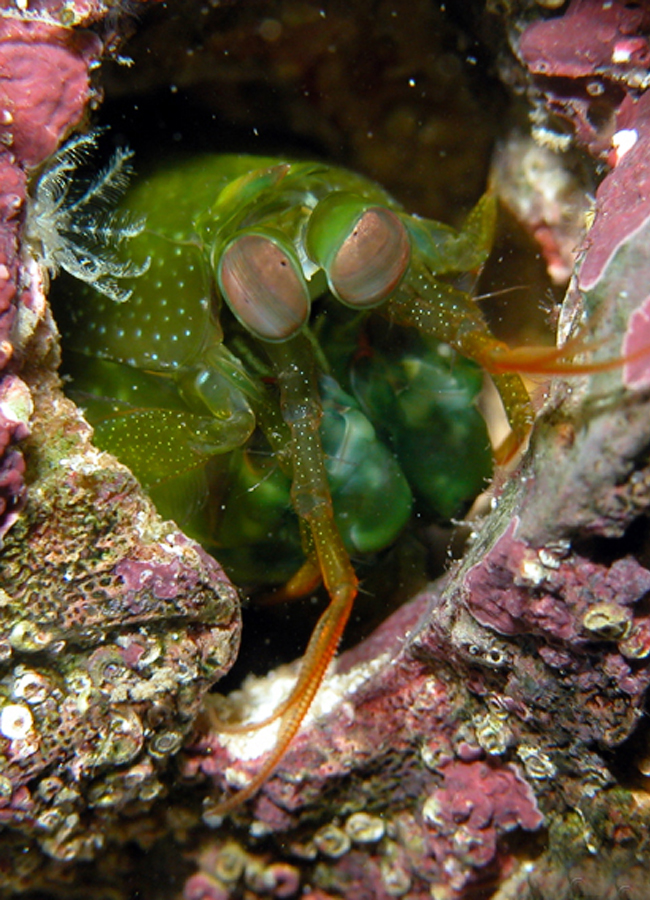
In fact, their eyes contain 16 different types of photoreceptors, 12 of which are for color analysis, compared to 3 in human eyes. This allows them to distinguish up to 100,000 colors, compared to around 10,000 seen by humans beings(8)(9). Their eyes also posses various color filters and polarization receptors, allowing them to see polarized light and 4 colors of UV light(10)(11). Impressive to say the least, and considered to be the most complex eyes of any animal we know of(12).
Also note that there are some general behavioral differences between the smashers and spearers. Smashers tend to live in holes in rocks, or rock rubble, but spend much of their time roaming about stalking prey. They tend to feed on crabs, snails, and other shelled victims, and will use their weapons to pound open their victims’ shells, eating the contents afterwards. Conversely, spearers tend to build and wait in burrows on soft sediment bottoms, and feed on fishes and other soft-bodied prey using an ambush technique. They stay in place and wait for prey to inadvertently come into their range, quickly reaching out to grab them. One may eat the other’s preferred food though, if the need and opportunity arise.
Other than that, there are a couple more interesting things about them that I’d like to point out. First, they may be the only invertebrates that can identify individuals of the same species by sight and smell. In other words, they can see, smell, and remember well enough that they know exactly who is who in the neighborhood(13)(14). And, some species may change color with changes in lighting and their surroundings. For example, some specimens from deep waters may be dark blue or reddish, but can change to bright green in a well-lit aquarium that houses macroalgae like Caulerpa. And, some of them are fluorescent, possessing yellow-green fluorescent spots making them easier to see in dim lighting(15). This is thought to be used to signal or threaten one another, and may be the only case of fluorescence being used in this way(15).
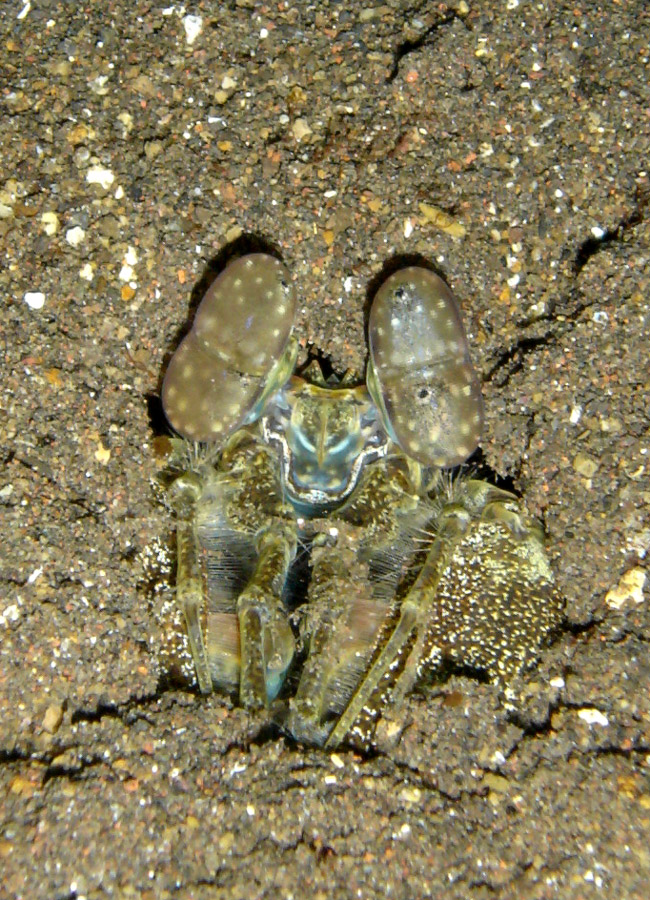
Smashers tend to live in holes in rockwork and rubble, but spearers tend to make burrows and wait patiently to ambush any suitable prey that gets too close.
I could keep going, but that’s enough about their biology. I’ve provided some sources for more information along with the references, and links to some good YouTube videos, too. Now, I’ll tell you a story about the first experience with keeping one of these.
My first mantis shrimp
Even after being in the hobby for many years, and reading/seeing various things about mantis shrimps, I had never felt the urge to get one. I invariably heard that they hide a lot, can be very aggressive, cannot be trusted with other invertebrates or small fishes, and can even be dangerous. I didn’t know of anyone personally that had one, either.
However, as I was shopping in Tampa one day, looking for something interesting to put in a 20 gallon aquarium I’d recently set up, I happened to come across a tiny, bright green smasher called Neogonodactylus wennerae. The aquarium didn’t have too much in it really, so with a rather spontaneous change of heart, I figured I’d go ahead and give one a try. It was only a few dollars and a small local species, so I figured if I didn’t like it I’d just let it go.
My 20 gallon contained a few good pieces of aquacultured live rock/coral rock, a sand bed, and two fishes. There were also a few snails and hermit crabs too, but I removed the 3 small Astraea snails, leaving behind 3 much larger Turbo snails. I left the hermits in, as well. With the exception of a relatively large spotted hermit (Dardanus megistos), the rest were small ones that I collected myself, and I considered the small ones to be expendable and the big one to be tough enough to take care of itself. After all, Neogo as I called it, was only an inch and a half or so in length at the time.
When introduced, it found a hole of some sort near the back side a large piece of live rock. Then, it started to jackhammer the inside of the rock and I could hear intermittent rapid popping sounds for a couple of days, or so. A hole later appeared on the front side of the rock, just above the level of the sand substrate. Upon inspection with a flashlight, I found that Neogo had enlarged the diameter of hole as well, making it big enough to turn around in. Afterwards, attention was turned to the opposite side of the tank and a burrow of sorts was excavated under a couple of other pieces of rock. Initially it stayed in one of the two locations about 99% of the time the lights were on, primarily in the rock.
Within a week all of the little hermits were gone. I even saw the attack once, as I happened to catch a small object flying up from the bottom immediately after hearing a distinctive tick, tick, tick sound. Another smack or two and the hermit’s shell was breached and the eating began. All of the barnacles on the aquacultured live rock were demolished and eaten, too.

My poor hermit was attacked and lost an eye in a split second, after living with Neogo for several months.
I collected more hermits, but I also started adding dried shrimp pellets. Neogo liked them, and also began eating flake food and brine shrimp when able to catch some. Even after several weeks, as best as I could tell, the mantis had made no attempts to eat the turbos or the big hermit, though. In fact, Neogo actually ignored them, even when they were very close together. Likewise, it seemed to eventually realize that I wasn’t a threat, and accordingly began to spend more and more time outside the hideouts, walking about. It began to give me the distinct impression that it was very curious, not just out looking for a meal, and enjoyed watching me as much as I liked watching it.
Over the next several months I added more corals, more fish, and even a skunk cleaner shrimp, with no problems. The mantis seemed to be content with the fish foods and occasional little hermits. But, for reasons unknown, Neogo decided to have a showdown with the big hermit one night, and I happened to be there to see it. It had grown significantly by this time, to around two and a half inches in length, and possibly decided it was now large enough to handle the hermit.
I watched as the mantis darted out of its burrow and smacked the hermit’s shell a couple of times. It was a pretty heavy shell though and nothing happened. The hermit just jerked in and sat there. So, the mantis retreated to its lair and waited for the hermit to come back out, then tried the same again. Still no damage to the hermit.
At this point I thought maybe the mantis was just harassing the hermit and might get tired of it and quit, but I was wrong. The third try was a charm, as the mantis caught the hermit before it could retreat, went for the head, and whacked off one of its stalked eyes. To save my hermit, I banged on the front pane of the tank, Neogo took off, and I yanked the hermit out just in time.
I thought about what to do for a bit and decided to pull the mantis out and move it elsewhere. At the time I was also playing around with a 56 gallon non-coral aquarium with lots of rocks and sand, but only a few other fishes and inverts that I had collected, and figured I’d transfer it over. So, I made a trap.
Neogo liked brine shrimp a lot, and would chase them around in the aquarium’s currents, giving me a good idea of what to do. I put some brine in a glass and covered the top with some clear plastic-wrap, only leaving a small gap at one side open. I positioned it near the mantis’ hole and about one inch from the side of the tank, then moved my magnetic cleaning magnet (that’s about one inch thick) in place just above the gap I’d left in the plastic.
Within a matter of seconds the mantis came out from its hole, located the gap in the plastic wrap, and went in for the food. I just as quickly came down with the magnet to block the opening. Still, I figured it would be a bad idea to leave it trapped in a glass container for more than a few seconds, and pulled a plastic breeder/holding box out of the closet before inserting the trap. So, I grabbed the glass, poured the mantis into the breeder box, added a piece of dead coral, and sank it in the aquarium. Success! Or so I thought.
I carried the glass to the kitchen, but before i could even make it back to the tank I heard the mantis pounding the side of the box. Before I could even get my hand in to grab the box, Neogo shot out of the corner and into the rockwork. The little *&%$* had knocked a hole in the container just big enough to squeeze out.
I was pretty irritated at this point, and guessed that the mantis was too, so I waited a while before repeating the same procedure. I was wary of using glass this time after seeing the hole in my box and used a clear plastic cup instead. I was actually kind of surprised that it worked just as well the second time, almost expecting it not to, and quickly pulled out the cup and poured the mantis directly into the other aquarium. Sorry, but no acclimation.
The story doesn’t end here though, as the two relatively large pistol shrimp living in the tank didn’t like the new company at all. Pistol shrimp are another odd sort of crustacean that has funny appendages, too. However, their’s are used to stun or kill other animals, as they’re built to make an extraordinarily loud popping sound and shock wave when closed quickly. Loud enough to be heard throughout the house, and loud enough to ring the bell of anything that bugs them, which Neogo apparently did.
www.youtube.com/watch?v=KkY_mSwboMQ
Anyway, I had unintentionally added these two shrimp with some rock, and they really got on my nerves at night sometimes, so I figured the mantis might feed itself a good meal and do me a favor, too.
Needless to say, the fireworks started that night. Pop, pop, pop… Pop, pop, pop… Pop, pop… It sounded like a gunfight. But, eventually the noise stopped and I figured they were done with each other. I assumed Neogo had been the victor, but the next morning the mantis was laid out, in the open, with legs up, and sitting perfectly still. Dead.

Pistol shrimps are also unique crustaceans, which have an enlarged claw capable of popping so loudly that it can stun or even kill other creatures.
I reached in to pull out the lifeless body, only to realize that it wasn’t so lifeless. It popped a slit in my finger and the blood was running fast before I could get my hand out of the water. So, I learned where they get their nickname – the hard way. This is why stomatopods are often called “thumb splitters”.
I cleaned up the wound and bandaged it, and left the mantis where it was. It never moved from where it came to rest though, and after waiting several hours I removed it with some chopsticks. Yes, it was really dead this time. So, I took a few pictures of the pretty green corpse, and then pulled it apart for fish food, and even gave the big one-eyed hermit some.
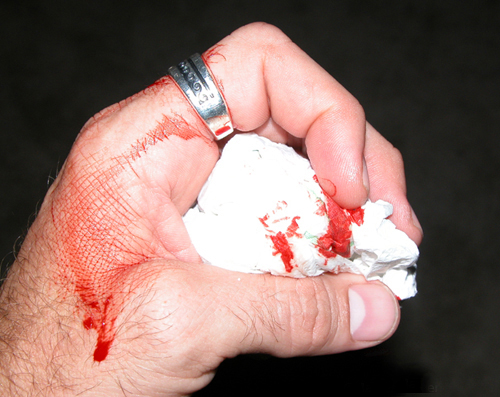
Watch out! I got careless, and I paid the price. This is why stomatopods are often called “thumb splitters”.
Aquarium care for a mantis shrimp
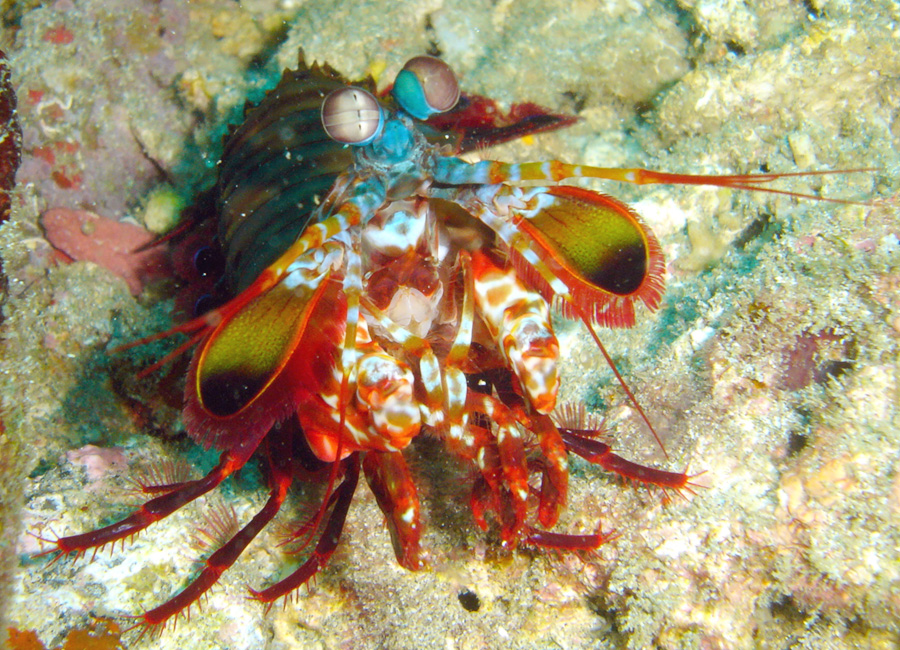 Despite my story, if you decide that a mantis shrimp is something that you want to try, you have a few choices when it comes to making a home for them and taking care of them. Putting either type (smasher or spearer) in a reef can obviously be bad idea if you plan on having much of anything else that is made of meat and moves around the bottom. But, as far as I know, my little smasher never bothered the large turbos or the cleaner shrimp, which stayed at the top of the tank most of the time, or any of the 4 small fishes, either. It also never posed a threat to the corals. So, I’d think with some appropriate stocking choices, it is possible to keep a smaller species of stomatopod in a full-blown reef tank. And, of course, either could also be kept in a non-reef tank, as long as the fishes are big enough to fend for themselves.
Despite my story, if you decide that a mantis shrimp is something that you want to try, you have a few choices when it comes to making a home for them and taking care of them. Putting either type (smasher or spearer) in a reef can obviously be bad idea if you plan on having much of anything else that is made of meat and moves around the bottom. But, as far as I know, my little smasher never bothered the large turbos or the cleaner shrimp, which stayed at the top of the tank most of the time, or any of the 4 small fishes, either. It also never posed a threat to the corals. So, I’d think with some appropriate stocking choices, it is possible to keep a smaller species of stomatopod in a full-blown reef tank. And, of course, either could also be kept in a non-reef tank, as long as the fishes are big enough to fend for themselves.
In any case, you’ll need to do as much homework as possible (Do as I say, not as I do. Right?) and will most likely want to find a smaller species to try. All will appreciate a natural setting, including a deep sand bed and some live or base rock. Many will also take up residence in some appropriate diameter, well-placed PVC pipe, and/or a big snail shell. Otherwise, a smasher will likely end up building its own home in your rock.
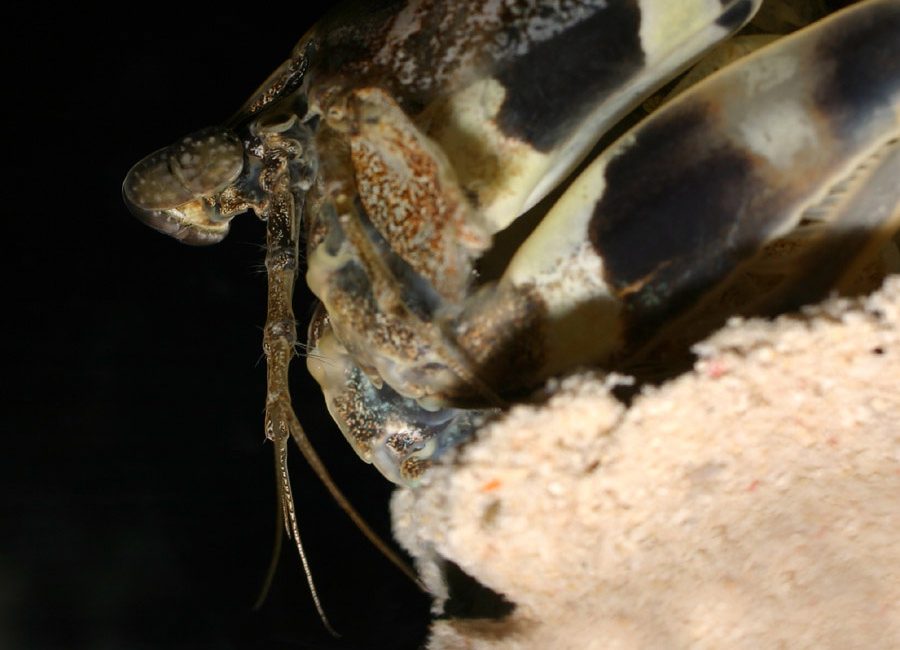
On the top is the peacock mantis, Odontodactylus scyllarus, which is the most popular species offered in the hobby. It’s a smasher that reach 6 inches in length. On the bottom is a zebra mantis shrimp, a huge spearer that I believe is Lysiosquillina maculata. This one is the largest species, sometimes reaching almost 16 inches in length, and I’ve seen a half-dozen or so of these offered at stores.
For spearers in particular, it’s often advised to have a sand bed that’s one and a half times as deep as the animal is long. And, it’s a good idea to add some crushed shell, and/or bits of coral skeleton, which they’ll typically use to stabilize the walls of their burrow.
As far as breaking out of things goes, fortunately the smaller species aren’t likely to knock your tank apart, especially if they are spearers. As long as a mantis shrimp feels “happy” and doesn’t feel threatened, it shouldn’t have any reason to do so anyway. So, don’t make one feel threatened. The tank busting stories are actually very few and very far between as best as I can tell. Regardless, somewhere along the line I did hear about putting a piece of plexiglass on the bottom of the tank, under the sand, to keep one from breaking out the bottom while burrowing. So, this may be worth a few dollars for a little peace of mind if nothing else. Of course, an all acrylic tank would probably hold up much better than a glass one, if you’re that worried about it.
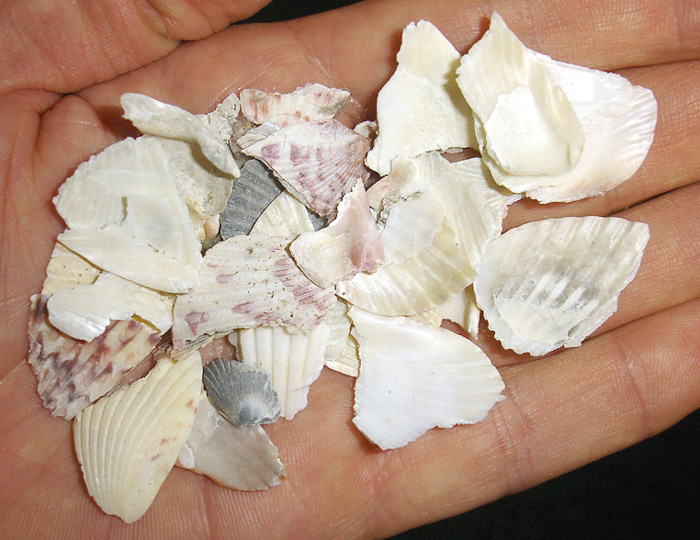
Adding crushed shell like this for a spearer will provide it with material to stabilize the walls of its burrow.
Anyway, when it comes to feeding, I know everyone doesn’t have access to free hermits. But, as best as I can tell, all mantis shrimps can adapt to aquarium life and will learn to take other foods. Pieces of meat are appreciated for sure, but as I pointed out, shrimp pellets, flake food, and brine shrimp worked fine for me, too.
So, there you have it. A good introduction to stomatopod biology and aquarium care. Again, these are my favorite invertebrates, and with a little planning and preparation can be fantastic acquisitions for any marine aquarist. In fact, after writing this, I feel a compulsion to go get another one…
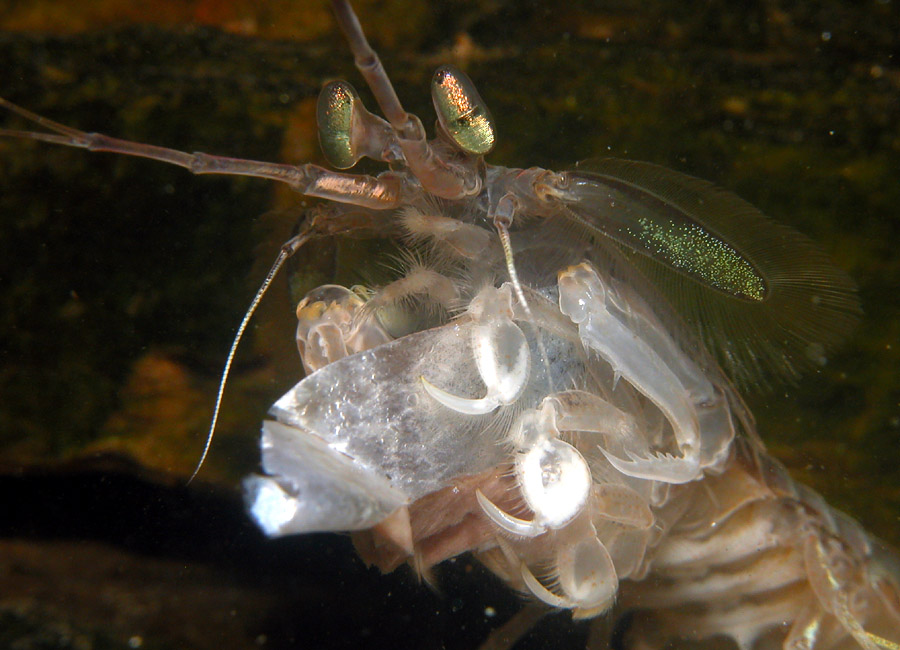
This is Oratosquilla oratoria, my other mantis shrimp. It’s a spearer that I got from a local fisherman while living in Japan, and a popular food item there. Here you can see “Orato” dining on a small piece of left-over sashimi.
References
- 1. Gonser, J. 2003. Large shrimp thriving in Ala Wai Canal muck. Honolulu Advertiser, Feb. 14.
- 2. Fossa, S. & Nilsen, A. 2000. The Modern Coral Reef Aquarium, Volume 3. Birgit Schmettkamp Velag, Bornheim, Germany. 448pp.
- 3. Patek, S.N., Korff, W.L. & Caldwell, R.L. 2004. Deadly strike mechanism of a mantis shrimp. Nature, 428:819-820.
- 4. Patek, S.N. & Caldwell, R.L. 2005. Extreme impact and cavitation forces of a biological hammer: strike forces of the peacock mantis shrimp”. Journal of Experimental Biology, 208 (19):3655-3664.
- 5. Holladay, A. 2006. Shrimp spring into shattering action. USA Today, September 1.
- 6. Yong, E. 2008. The mantis shrimp has the world’s fastest punch. Discover Magazine Blogs, URL: blogs.discovermagazine.com/notrocketscience/2008/07/19/the-mantis-shrimp-has-the-worlds-fastest-punch/#.UZZaILU3t8E
- 7. Yong, E. 2012. How mantis shrimps deliver armour-shattering punches without breaking their fists. Discover Magazine Blogs, URL: blogs.discovermagazine.com/notrocketscience/2012/06/07/how-mantis-shrimps-deliver-armour-shattering-punches-without-breaking-their-fists/
- 8. Cronin, T.W. & Marshall, N.J. 1989. A retina with at least ten spectral types of photoreceptors in a mantis shrimp. Nature, 339:137-139.
- 9. Cronin, T.W., Marshall, N.J. & Land, M.F. 1994. Vision in mantis shrimps. American Science, 82:356-365.
- 10. Marshall, N.J., Land, M.F., King, C.A. & Cronin, T.W. 1991. The compound eyes of mantis shrimps (Crustacea, Hoplocarida, Stomatopoda). I. Compound eye structure: the detection of polarized light. Philosophical Transactions of the Royal Society of London, 334:33-56.
- 11. Marshall, N.J., Land, M.F., King, C.A. & Cronin, T.W. 1991. The compound eyes of mantis shrimps (Crustacea, Hoplocarida, Stomatopoda). II. Polychromatic vision by serial and lateral filtering. Philosophical Transactions of the Royal Society of London, 334:57-84.
- 12. Kilday, P. 2005. Mantis shrimp boasts most advanced eyes. The Daily Californian, September 28.
- 13. Caldwell, R.L. 1985. A test of individual recognition in the stomatopod Gonodactylus festae. Animal Behavior, 33:101-106.
- 14. Caldwell, R.L. 1992. Recognition, signaling and reduced aggression between former mates in a stomatopod. Animal Behavior, 44:11-19.
- 15. Sanders, R. 2003. Mantis shrimp fluoresce to enhance signaling in the dim ocean depths. UC Berkeley News, November 14. URL: www.berkeley.edu/news/media/releases/2003/11/14_shrimp.shtml
Additional sources of information, and a few good videos
Secret of the Stomatopod. URL: http://www.ucmp.berkeley.edu/aquarius/index.html
Stomatopods for the Aquarium: The identification and care of mantis shrimps. URL: http://www.ucmp.berkeley.edu/arthropoda/crustacea/malacostraca/eumalacostraca/royslist/
The Lurker’s Guide to Stomatopods. URL: www.blueboard.com/mantis/
Crazy attacking Mantis Shrimp takes a ride with a Porcupine Pufferfish.
www.youtube.com/watch?v=91aHb9iOQ2w
(Idiot) Holding a huge mantis shrimp.
www.youtube.com/watch?v=BV9z5e1r2KM
Mantis shrimp destroyed my filter.
www.youtube.com/watch?v=mJL2Lgz5T8w
Mantis Shrimp Destroys Clam.
www.youtube.com/watch?v=i-ahuZEvWH8
Mantis shrimp vs octopus.
www.youtube.com/watch?v=H69cLQdLPfg
Mantis Shrimp vs. Several Crustaceans.
www.youtube.com/watch?v=9-PShMgas-0
Peacock Mantis Shrimp kills Blue-ringed Octopus.
www.youtube.com/watch?v=aZ7njTvDw0o
World’s Deadliest – Shrimp Packs a Punch.
www.youtube.com/watch?v=PpW9RIy7Gus
Zebra Mantis Shrimp attack good quality w/ slow motion.


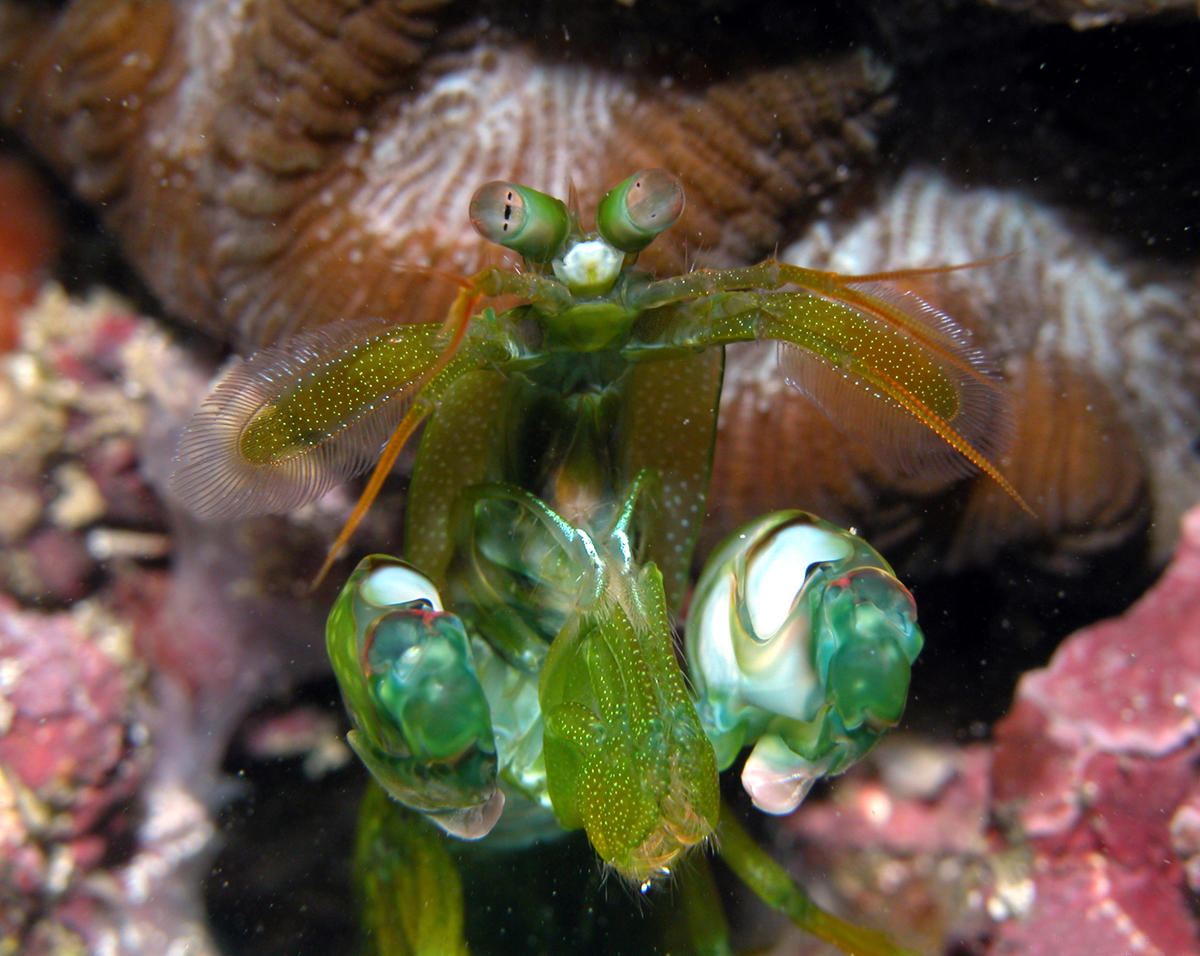
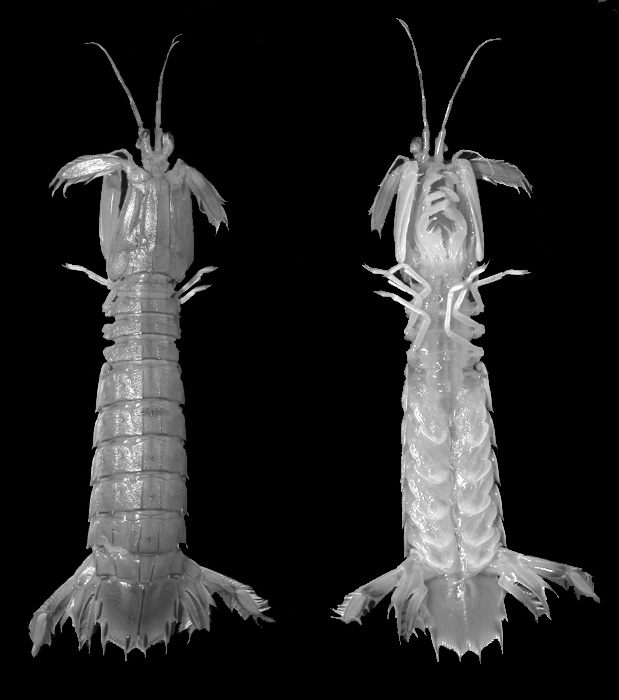
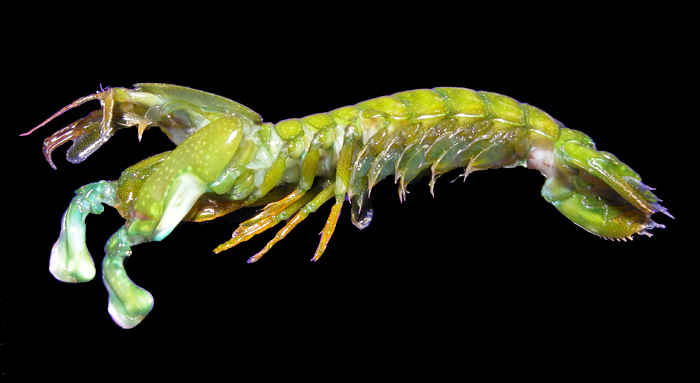
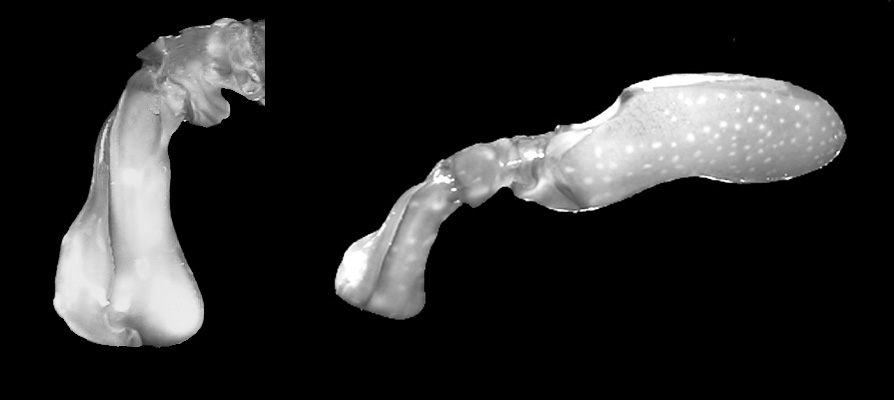
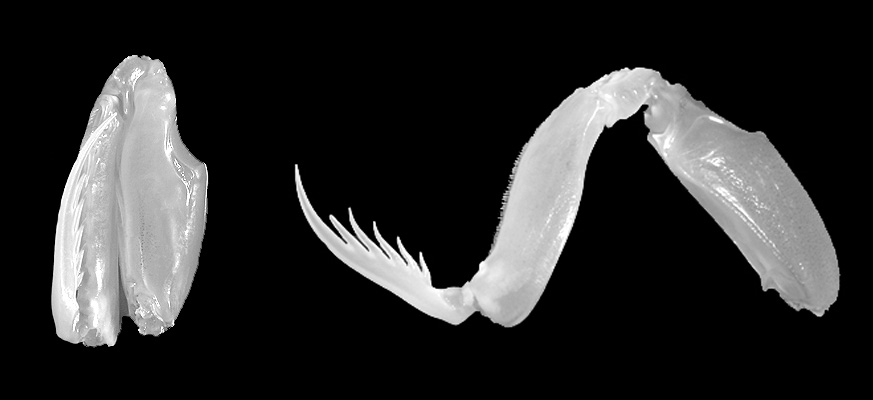

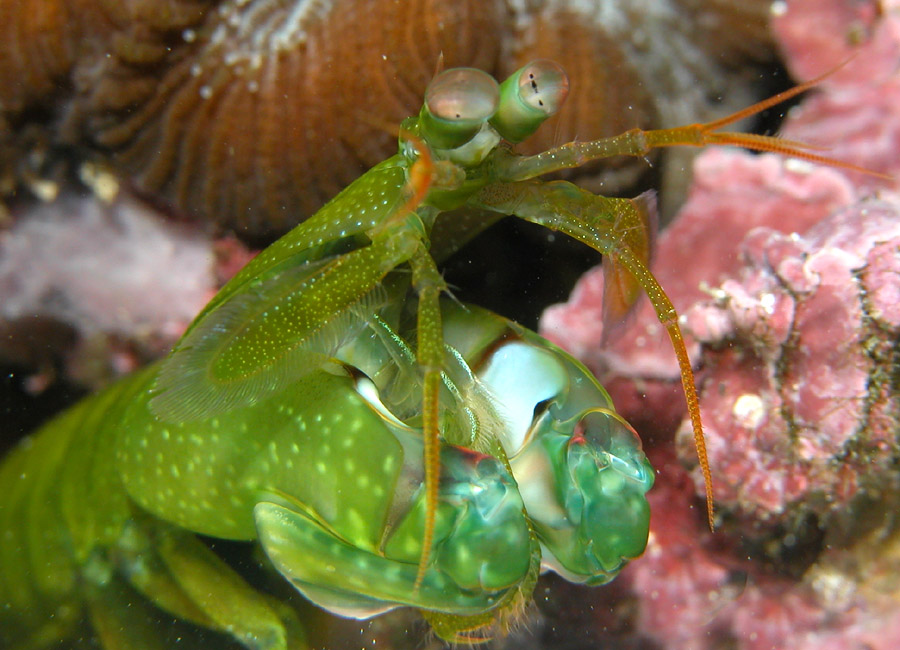
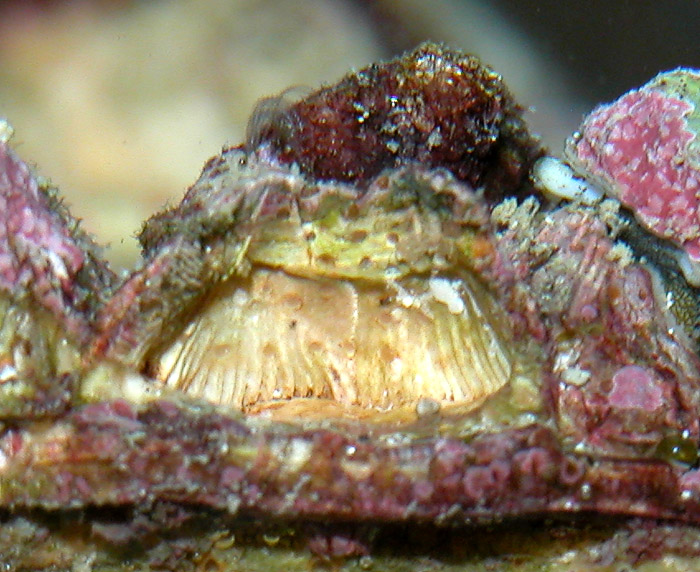
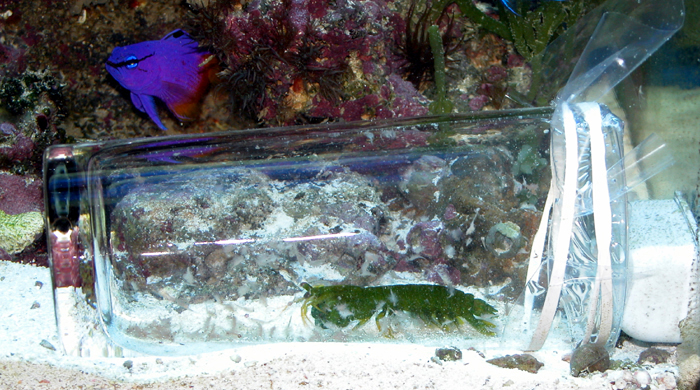
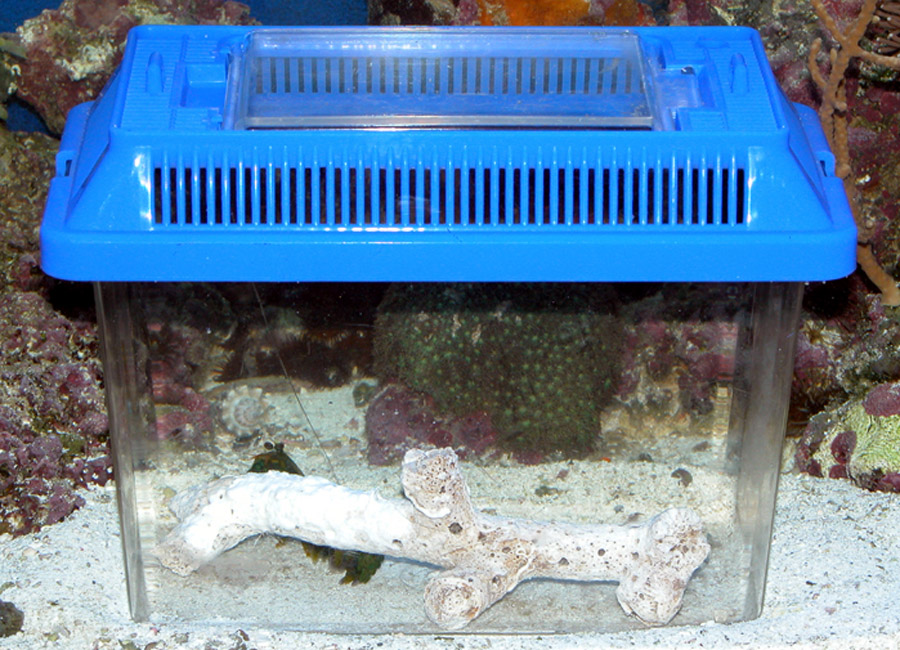

James,
Really enjoyed reading your article on Mantis Shrimps.
Thank you.